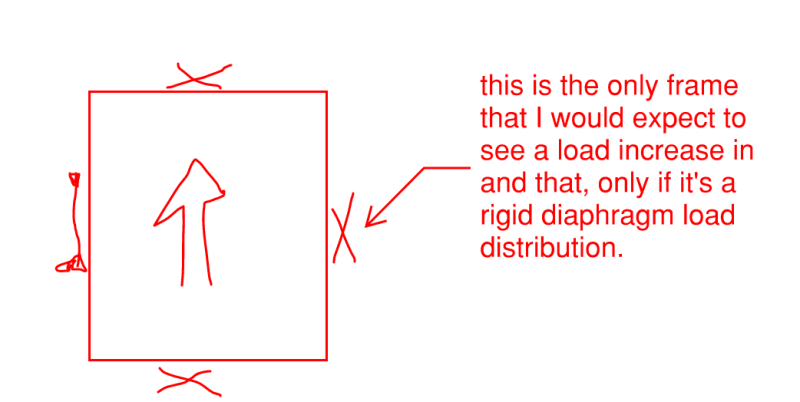hemiv
Structural
- Dec 7, 2018
- 78
Hi all.
I've been asked to provide a design allowing a PEMB owner to remove X bracing for new doors. I've done this before with chevron bracing and new beam, but this time the openings are going to be quite large and I don't have enough room for that.
So I'm going with a new portal frame. They bay in question is 27'7" wide and the eave height is 15'. Overall 80'x80' building. The bracing is visible on the wall I'm reworking, but the other three walls of the building have an interior plywood wall covering and I cannot see the LFRS elements. There are no drawings available for this building. And of course no one wants me to get into to analyzing this whole building, which would cause the business to shut down in order to move a lot of equipment and remove all the interior wall coverings.
So my plan is to proceed with the design with the 10% rule for lateral loads - I'm not designing any additions, so new lateral loads will be induced in the system - while also designing the portal frame to be quite stiff and reduce the amount of load the other elements of the LFRS will take as redistributions.
Just wanted to get some extra thoughts on this approach. I know the existing elements of the LFRS which are perpendicular to the new portal frame will take load if the portal frame is too soft, so I am primarily trying to eliminate this from happening as much as possible.
I've been asked to provide a design allowing a PEMB owner to remove X bracing for new doors. I've done this before with chevron bracing and new beam, but this time the openings are going to be quite large and I don't have enough room for that.
So I'm going with a new portal frame. They bay in question is 27'7" wide and the eave height is 15'. Overall 80'x80' building. The bracing is visible on the wall I'm reworking, but the other three walls of the building have an interior plywood wall covering and I cannot see the LFRS elements. There are no drawings available for this building. And of course no one wants me to get into to analyzing this whole building, which would cause the business to shut down in order to move a lot of equipment and remove all the interior wall coverings.
So my plan is to proceed with the design with the 10% rule for lateral loads - I'm not designing any additions, so new lateral loads will be induced in the system - while also designing the portal frame to be quite stiff and reduce the amount of load the other elements of the LFRS will take as redistributions.
Just wanted to get some extra thoughts on this approach. I know the existing elements of the LFRS which are perpendicular to the new portal frame will take load if the portal frame is too soft, so I am primarily trying to eliminate this from happening as much as possible.

